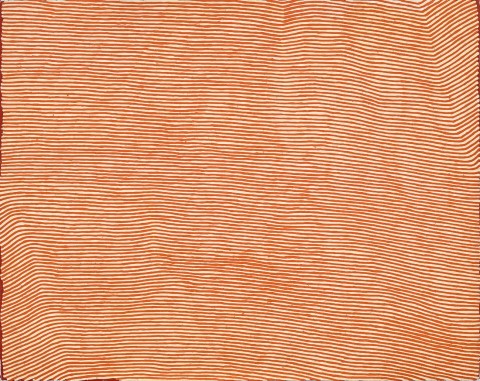UNTITLED, 2005
GEORGE TJUNGURRAYI
synthetic polymer paint on Belgian linen
122.0 x 153.0 cm
bears inscription verso: artist’s name, size and Papunya Tula Artists cat. GT0503198
Papunya Tula Artists, Alice Springs, Northern Territory
Shalom Gamarada Art Exhibition, University of New South Wales, Sydney
Private collection, Sydney, acquired from the above in 2005
Shalom Gamarada Art Exhibition, Eric Caspary Learning Centre at Shalom College, University of New South Wales, Sydney, 24 – 28 July 2005, cat. 17
Since the late 1980s art emerging from Papunya Tula has re-invented itself at regular intervals. Traditional representations of the Tingari creation cycle, the roundels, connecting meandering lines and dots have given way to optical line work that reduce the painting to a simplicity of rhythm and tone, a variation and development that Judith Ryan refers to as 'a radical form of expression akin to western forms of minimalism in art and music'.1
The repeated rhythmic and optical patterns in the paintings of George Tjungurrayi generate a hypnotic effect where the interplay of undulating broad parallel lines, composed of different tones of the one colour, creates a mesmerizing surface. His compositions inspired by traditional narratives are derived from the distinctive western desert style of fluted carving of fine parallel lines carved into men’s ceremonial shields and boomerangs. Tjungurrayi has transposed these designs onto canvas utilising both the motifs and the sculptural elements to create an extra dimension to the surface of his canvases.
1. Ryan, J., ‘Shock of the Ancient made New’, in Laverty, C., Laverty, E., and Kleinmyer, J., Beyond Sacred: Recent painting from Australia's remote Aboriginal communities: The collection of Colin and Elizabeth Laverty, Hardie Grant Books, Prahran and Bambra Press, p. 16
